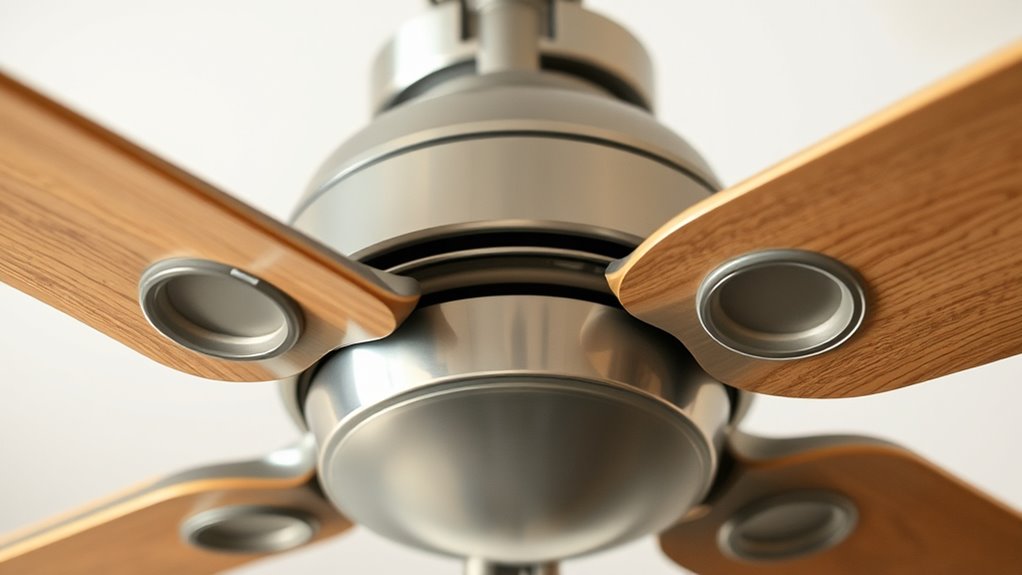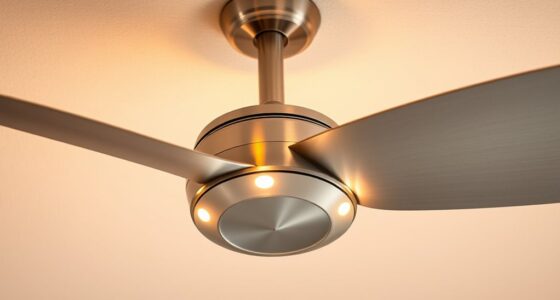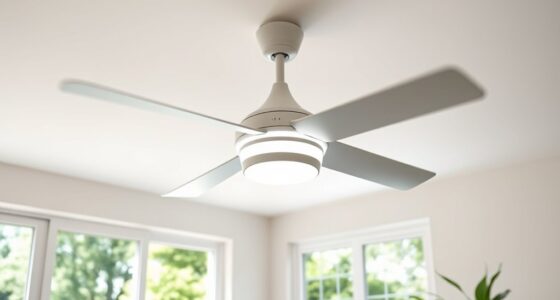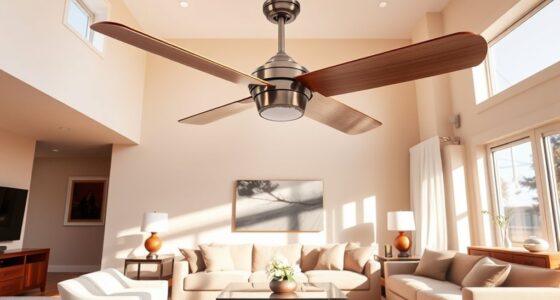Your ceiling fan wobbles mainly because the blades are unbalanced, loose, or warped, or the motor isn’t aligned properly. You can fix this by tightening mounting screws, cleaning and checking for damage on the blades, and balancing them using small weights. Ensuring your motor sits flush and isn’t misaligned also helps. If you want to learn step-by-step tips to stop the wobbling and keep your fan running smoothly, keep going.
Key Takeaways
- Dust buildup, warping, or manufacturing flaws can unbalance blades, causing wobbling. Regular cleaning and inspection help prevent this.
- Check for loose mounting screws or brackets, tightening them ensures the fan remains stable during operation.
- Use a blade balancing kit to identify and correct uneven weight distribution on the blades.
- Ensure the motor is properly aligned and securely attached to avoid misalignment-induced wobbling.
- Regular maintenance, including cleaning and tightening hardware, can prevent future wobbling and maintain safe operation.

A wobbling ceiling fan can be both annoying and potentially dangerous, but fixing it is often straightforward. The most common causes of wobbling are unbalanced blades and misaligned motors. Addressing these issues can restore your fan’s stability and quiet operation without professional help. First, check if your fan’s blades are properly balanced. Over time, blades can become uneven due to dust buildup, warping, or slight manufacturing flaws. To balance them, start by turning off the fan and inspecting each blade. Clean off any dust or debris that may have accumulated, as uneven weight distribution can contribute to wobbling. If the blades appear warped or damaged, consider replacing them.
A wobbling ceiling fan is often caused by unbalanced blades or misaligned motors, which can be fixed easily.
Next, use a blade balancing kit, which typically includes a clip and small weights. Attach the clip to the blade you suspect is causing the imbalance, then spin the fan gently. Observe which side causes the wobble and add small weights to the opposite side of that blade to counteract the imbalance. Keep adjusting until the wobbling diminishes or stops. This process ensures blade balancing, which is often the simplest fix for a wobbly fan.
If balancing the blades doesn’t resolve the issue, you should then check motor alignment. A misaligned motor can cause the blades to sit at slightly different angles, creating uneven forces that lead to wobbling. To do this, turn off the fan and carefully examine the mounting bracket and the motor housing. Ensure that the mounting screws are tight and that the motor is securely attached to the ceiling. Sometimes, the mounting bracket can loosen over time, causing the motor to shift out of alignment. Tighten any loose screws and verify that the motor sits flush against the bracket.
In some cases, the motor itself may be slightly off-center or misaligned. If you notice any wobbling even after securing all mounting points and balancing the blades, you might need to adjust the motor alignment. This involves loosening the mounting screws slightly to reposition the motor housing, then tightening everything back securely. Be cautious not to overtighten, as this could damage the components. If you’re unsure or uncomfortable, consulting the fan’s manual or calling in a professional can help ensure proper alignment.
Regular maintenance, including cleaning the blades, tightening screws, and inspecting mounting hardware, can help prevent future wobbling issues. Ultimately, fixing a wobbling ceiling fan involves a combination of blade balancing and ensuring the motor is correctly aligned. By following these steps, you keep your fan running smoothly, quietly, and safely, avoiding the risk of damage or injury.
Frequently Asked Questions
Can a Wobbling Ceiling Fan Cause Electrical Issues?
A wobbling ceiling fan can pose electrical hazards if the imbalance causes the fan motor issues or loose wiring. While wobbling itself doesn’t directly cause electrical problems, it can lead to stress on electrical connections, increasing the risk of shorts or sparks. To prevent potential hazards, you should inspect and fix the wobble promptly. Proper maintenance guarantees your fan operates safely, minimizing the risk of electrical faults or damage.
How Often Should I Balance My Ceiling Fan?
Fan maintenance matters for maximizing your ceiling fan’s lifespan. You should check and balance your fan every six to twelve months to prevent wobbling and wear. Regularly inspecting blades, tightening screws, and cleaning debris keep it spinning smoothly. This consistent care prevents unnecessary wobbling, prolongs the fan’s life, and preserves efficient airflow. When you stay proactive with fan maintenance, you guarantee your fan remains functional, safe, and steadfast for years to come.
Is It Safe to Fix a Wobbling Fan Myself?
Fixing a wobbling ceiling fan yourself can be safe if you follow proper DIY safety precautions, like turning off the power and using the right tools. However, if you’re unsure or uncomfortable, it’s best to seek professional repair to avoid injury or damage. Always assess your skill level first; when in doubt, hiring a professional ensures the job gets done safely and correctly, preventing future issues.
Will Replacing the Fan Blades Stop the Wobble?
Imagine you’re back in the ’80s, rocking out with a stable ceiling fan. Replacing the fan blades can improve ceiling fan stability, but it might not fully stop the wobble if other issues exist. Fan blade replacement helps balance the fan, but verify blades are undamaged and properly aligned. Sometimes, adjusting mounting hardware or tightening screws is needed to achieve that smooth, wobble-free spin you want.
What Tools Are Needed to Fix a Wobbly Ceiling Fan?
To fix a wobbly ceiling fan, you’ll need basic tools like a screwdriver, pliers, and possibly a ladder. Check the mounting hardware to make certain it’s secure and tight. Use balancing techniques, such as adding a ceiling fan balancing kit or adjusting the blades, to stabilize the fan. These tools and methods help you properly secure the fan and reduce wobbling, ensuring safer and quieter operation.
Conclusion
So, next time your ceiling fan wobbles unexpectedly, remember that sometimes, a simple fix is all it takes—like checking the blades or tightening a screw. It’s funny how little things often cause the biggest disruptions, almost like fate nudging you to pay attention. Fixing your fan not only restores comfort but also saves you from bigger headaches down the line. After all, a steady fan keeps your home feeling just right, no matter what surprises come your way.









